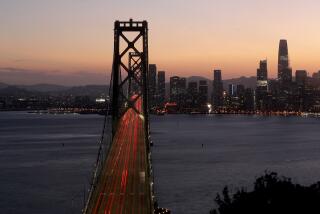It’s a bumpy ride on the Hydrogen Highway
Cadillac unveiled a concept car this week that runs partially on hydrogen, adding to the ranks of futuristic vehicles powered by the universe’s most common element. Yet even if you could drive it -- there’s only one now -- you couldn’t get from L.A. to San Francisco, because there aren’t enough fueling stations.
The state, through its Hydrogen Highway program, has been pushing to create a network of 100 hydrogen fueling stations by 2010. But the closure of two stations in recent weeks, and the pending closure of a third next month, will drop the number to 22. In addition, all three of the stations that California’s Air Resources Board has agreed to finance have fallen through, most recently one to be erected by Pacific Gas & Electric in San Carlos, near San Francisco.
California’s struggles underline the chicken-and-egg problem of hydrogen technology, which has been touted as a zero-emissions alternative to traditional engines. Which comes first: the cars or the pumps?
Like gasoline, hydrogen has to be administered through fueling stations. But with no hydrogen-powered vehicles publicly available, except as test cars or city buses, there is little demand for the volatile gas; that lack of demand is in turn a disincentive to create hydrogen stations.
“Infrastructure is a very important hurdle to surpass before this technology can work,” said Charles Territo, spokesman for the Alliance of Automobile Manufacturers, the car industry’s lobby group. “Our role is to produce vehicles, but we need places to fuel them.”
Nearly every major carmaker has made a limited number of experimental hydrogen-powered vehicles.
On Jan. 1, hydrogen generation equipment maker Hydrogenics shuttered the fueling station in Richmond, in Northern California, saying that running a station was not part of its business priorities. Meanwhile, a station in Sacramento run by a consortium of energy and technology companies ceased operation on Dec. 31, forcing the Air Resources Board to address the matter in a meeting this week. (The board expects it to reopen within weeks.) And PG&E says in February it will close a San Francisco station it has run for several years.
But the three stations that never got off the ground are raising the most eyebrows. All three contracts were awarded in May 2006, for amounts ranging from $1.1 million to $1.25 million. Last spring, however, the award to Cal State L.A. was rescinded because of contractual disagreements. And in October, the San Diego Unified School District, chosen to build a station that creates and dispenses its own hydrogen using wind energy, also fell through, because the school district never acquired the necessary land.
Just before Thanksgiving, PG&E’s contract with the state also fell through. Jennifer Zerwer, a spokeswoman for the utility, said it disagreed with the Air Resources Board over how the station should operate. The state expected PG&E to generate the hydrogen it dispensed on site, but the utility, eager to invest in other alternative vehicle technologies, wanted only to sell hydrogen created elsewhere.
“We took a look at where the technology was, and hydrogen seemed like a much longer-term solution,” Zerwer said. She says the utility plans to find other financing to implement a less costly trailer-mounted station in the same San Carlos location that should be open by the end of the first quarter.
“We’re trying to jump-start something in a matter of years with a relatively modest budget,” said Mary Nichols, Air Resources Board chairwoman. “The original goal was 100 stations by 2010, but I would judge success more by whether we have stations where there are vehicles that need them.”
With other technologies like gasoline hybrids commercially available, critics say the difficulties in establishing a hydrogen infrastructure are an indicator that money might be better spent on other kinds of vehicles.
“It is imperative that we return to implementing the most proven alternative-fuel options now, possibly integrating others as they become viable,” said Chelsea Sexton of Plug In America, a group backing battery-powered and plug-in hybrid technology. “These new developments underscore just how dubious it is for near-term hydrogen-powered vehicles to be widely available.”
For now, the state says it will continue its effort to expand the number of hydrogen stations; this year it plans to call for proposals for $7.7 million to create three installations and update existing ones.
Cal State L.A. spokesman Sean Kearns said the school would request a contract.






